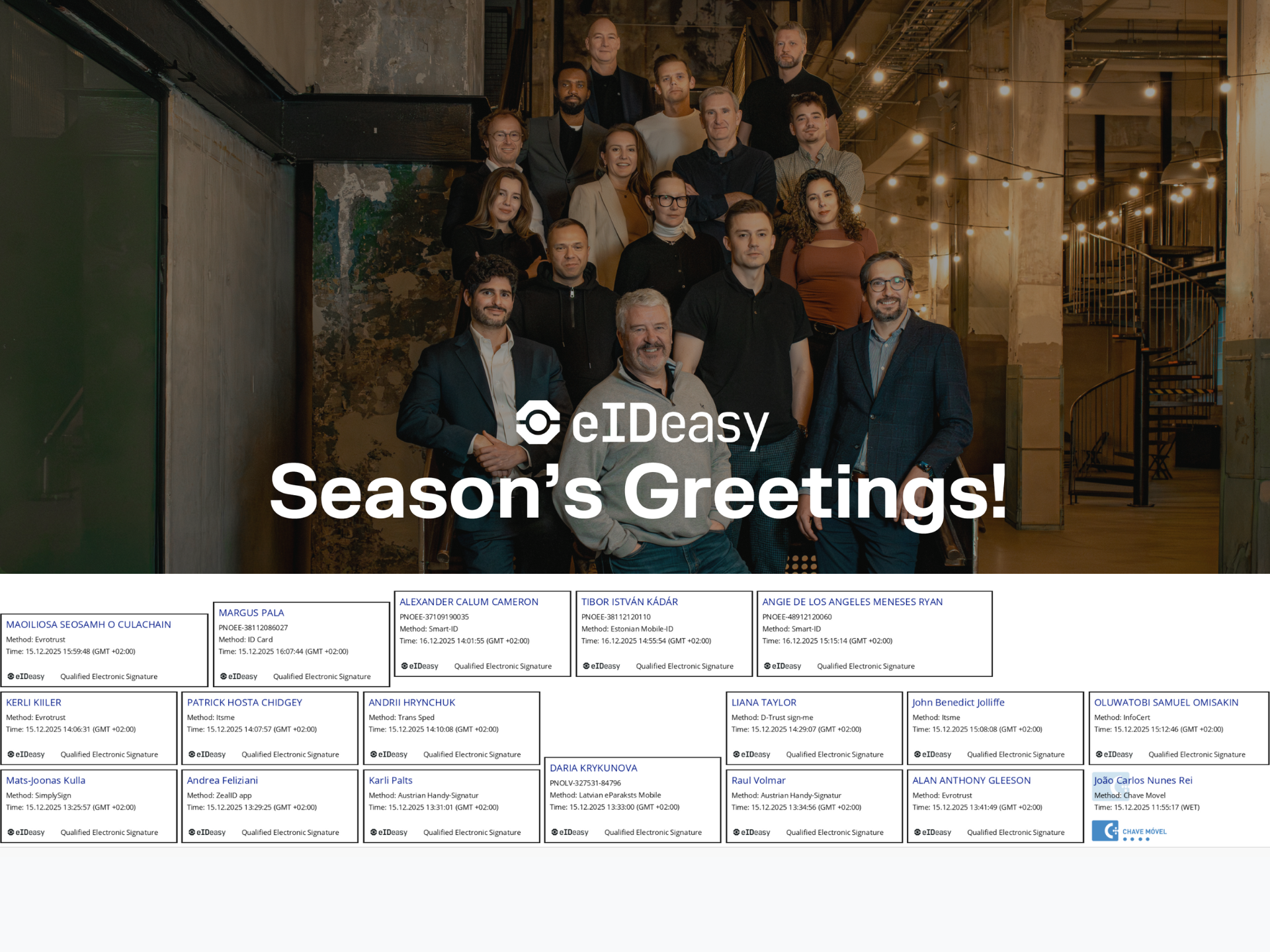Document management platforms are no longer just about storing files. They’re about moving business forward with contracts, onboarding forms, HR documents, and financial agreements. And none of those matter without signatures.
The challenge? Not all signatures are created equal. Different countries have different regulations, industries have strict compliance requirements, and customers want to use the signing methods they already trust.
This is where Qualified (QES) and Advanced (AdES) electronic signatures come in. And for document management providers, understanding them, along with related topics like KYC, customer onboarding, and eSeals, is essential.
To help, we’ve put together this comprehensive FAQ. Whether you’re evaluating solutions or just want to understand the landscape, you’ll find clear answers here.
Basics of eSignatures
What is an electronic signature (eSignature)?
An electronic signature is any digital mark or action used to sign a document — from typing your name to clicking “I agree.” Some are simple acknowledgments, others are identity-verified and legally binding.
What’s the difference between Simple, Advanced (AdES), and Qualified (QES) signatures?
- Simple Electronic Signature (SES): The most basic level — for example, checking a box or typing your name. Easy, but not legally strong.
- Advanced Electronic Signature (AdES): A signature linked to a verified identity and uniquely bound to the signer. Stronger, more secure, widely accepted.
- Qualified Electronic Signature (QES): The gold standard. It’s based on a qualified certificate issued by a Qualified Trust Service Provider (QTSP), and under eIDAS law in the EU it is legally equivalent to a handwritten signature.
When is a QES required?
QES is often mandatory in highly regulated areas like finance, healthcare, government transactions, or high-value contracts. Think bank loans, healthcare records, or notarized agreements.
What standards apply in Europe?
In the EU, QES is defined by eIDAS. In Switzerland, it’s covered by ZertES. Both create frameworks that guarantee recognition and legal equivalence.
Compliance & Security
What is a Qualified Trust Service Provider (QTSP)?
A QTSP is an accredited organization under eIDAS (or local frameworks) that provides digital trust services such as issuing certificates and enabling QES. They’re what makes a QES legally binding and enforceable.
Can I choose which QTSP to use?
Yes. With eID Easy, it’s up to you how to mix and match providers. We offer different bundles and flexible setups so you can work with the QTSPs that best fit your geography, compliance needs, and budget.
How do QES and AdES ensure legal validity?
They link the signature to a verified identity and are backed by QTSP-issued certificates, which makes the signature verifiable and tamper-proof.
Are QES signatures recognized across borders?
Yes. A QES created under eIDAS is valid in every EU country. Through ZertES, Switzerland has its own framework that is widely interoperable.
How does eID Easy help with changing regulations?
We manage integrations with national eIDs and QTSPs, updating them as laws or systems change, so you don’t have to constantly rebuild.
What about audit trails and evidence?
Every signature carries a verifiable trail: timestamps, identity method used, certificate details, and more — so you have the evidence if a signature is ever challenged.
Where are the certificates stored?
Certificates are issued and stored by accredited QTSPs. eID Easy never stores private keys or sensitive certificate data.
Technical Integration
How can a document management platform integrate QES?
With one API. eID Easy connects you to more than 80 eIDs and QTSPs through a single integration.
Do I need to connect to every provider myself?
No. We handle that complexity, so you don’t spend resources chasing every provider or regulation.
How fast can new signing methods be added?
Very fast. With eID Easy, adding a new signing method can take just a few hours. For example, Oneflow, a digital contracting platform, reduced integration time from days to hours.
Can signatures be embedded directly in my platform?
Yes. With our widget and API, the entire signing flow happens inside your platform, creating a seamless user experience.
Do you support batch signing (signing multiple documents at once)?
Yes. Users can sign a set of documents in one step, which is especially valuable for HR, finance, and legal teams.
What is a one-shot signature, and do you support it?
A one-shot signature means the user doesn’t need to pre-register for a certificate; it’s issued instantly for that signing event. We support this model, including providers like Adacom.
Do you offer sandbox or test environments?
Yes. You can test the full signing flow before going live.
Identity Verification (KYC) & Onboarding
Why is KYC important in document management?
KYC (Know Your Customer) ensures the signer really is who they say they are. It’s critical in regulated industries and helps prevent fraud.
Can eSignatures be tied to verified identities?
Yes. With eID Easy, signatures can be tied to national eIDs, bank logins, or other trusted identity methods.
How does eID Easy support customer onboarding?
Our API lets users authenticate with their national eID or another identity method at sign-up or signing. That way, onboarding is smooth, compliant, and secure.
Does this work for regulated industries like finance or healthcare?
Yes. Our compliance with eIDAS, ZertES, and other local frameworks makes eID Easy a strong fit for industries where security and regulation are non-negotiable.
eSeals & Organizations
What is an eSeal?
An eSeal is a digital seal applied by an organization to confirm the authenticity and integrity of a document.
How is it different from an eSignature?
An eSignature is tied to an individual person. An eSeal is tied to a legal entity like a company or public body.
When should eSeals be used?
They’re typically used to certify invoices, official records, reports, or any document issued by an organization.
Do eSeals also require a QTSP?
Yes. For an eSeal to be legally recognized under eIDAS, it must be issued by a Qualified Trust Service Provider. But don't worry, eID Easy takes care of everything.
Coverage & Providers
Which eID and signing methods are supported?
Over 80 and growing — including BankID, Smart-ID, itsme®, Evrotrust, InfoCert, Adacom, and more.
Can I mix local providers with eID Easy?
Yes. Many clients combine their existing providers with our bundles for broader coverage.
Use Cases & Industries
Who benefits most from QES/AdES in document management?
Any platform dealing with sensitive, regulated, or cross-border documents: finance, healthcare, HR, legal tech, government.
What are typical use cases?
Employment contracts, financial onboarding, rental agreements, notarized documents, cross-border B2B agreements.
Does it scale internationally?
Yes. One integration with eID Easy supports multiple countries and compliance frameworks.
Practical Considerations
How much developer effort is needed?
Minimal. One integration covers dozens of providers, and we handle updates when providers change their systems.
What does the user experience look like?
Users sign with the tools they already know — BankID, Smart-ID, itsme®, Evrotrust, and many others — directly inside your platform.
How is pricing structured?
Pricing depends on geography, compliance needs, and transaction volume. We offer flexible bundles so you can align with your market and regulatory environment.
Can I test before committing?
Test it now — try the real eID and signature flow with no setup required.
With eID Easy, you get one API that covers QES, AdES, KYC, onboarding, eSeals, and more. It’s the fastest way to offer your customers trusted signing methods everywhere they do business, while keeping your team focused on what really matters: building a great platform.



